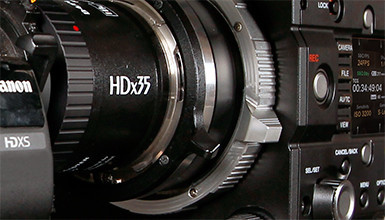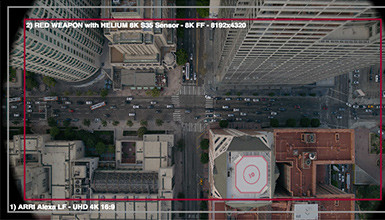These are both great questions, which we can generally answer with a simple yes or no. But they bring up some really interesting points, which all modern cinematographers need to understand when choosing a lens, camera, and recording format. So this article is all about lenses, image circles, sensor sizes and resolutions. The best place to start is lens ‘image circle’ and exactly what that means.
Circles of Confusion
When we talk about a lens, we often describe it by the film format or sensor size that it is designed to work with. Super 35mm lenses are designed to work with Super 35mm film or sensors that are around the same size; Super 16mm lenses are designed to work with Super 16mm film or the like sensors, etc. This can be confusing in itself, as we talk about lens focal length in millimeters as well. You can have a 35mm (focal length) Super 16mm lens for instance, and a 16mm (focal length) Super 35mm lens.
When we describe a lens as being designed for Super35 or 16mm film, we are actually talking about the image circle of a lens. Lenses are designed to project out a circular image onto a sensor or film plane. The size of the projected image circle is based on the design of a lens. An average ‘Super 35mm’ lens has an image circle diameter of around 32-35mm, while an average ‘Super 16mm’ lens has an image circle diameter of around 15-18mm. Lenses designed for smaller formats, usually in video cameras, are often referred to in inches. A 2/3” type lens has an image circle of around 11mm, and a 1/2" lens image circle is around 8mm.
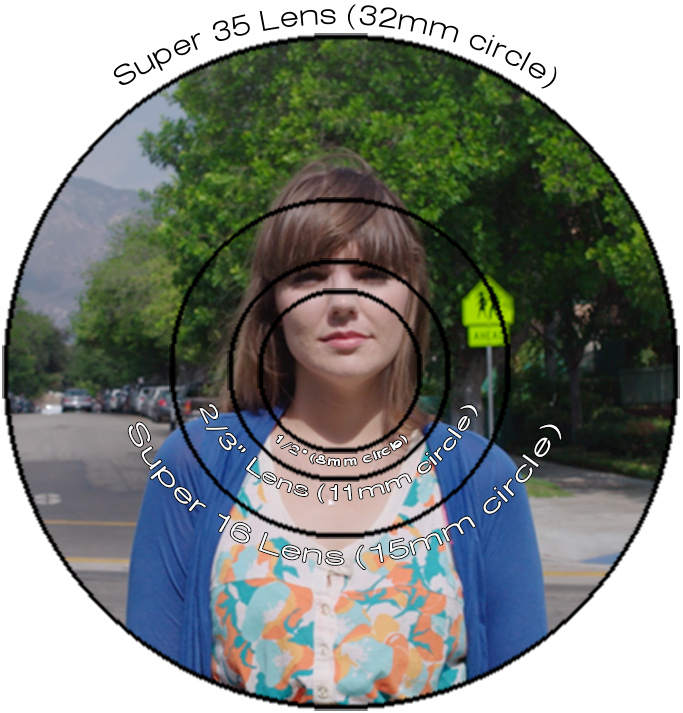
In the graphic above, you see Super35, Super16, 2/3”, and 1/2" image circles on top of each other. This photo was taken on a 50mm (focal length) lens. If it were a Super35 type lens, we would get the outside image; if it were Super16, we would get the image outlined for that, and so on. The focal length of the lens is exactly the same; we just get more of the image with the larger image circle. Focal length is unrelated to image circle, which is a big point of confusion for many of us. A 100mm lens has the same focal length regardless of its lens type; the difference is just how big of an image circle it projects.
Cover Me!
So hopefully you understand the image circle concept. Now lets discuss how it plays together with sensor (or film) size. Super 35mm film is standardized at 24.9mm × 18.7mm (31.1 diagonal), but our modern digital sensors come in a variety of shapes and sizes. From the large Full Frame 35mm sensors found in many DSLRs, to the small 1/2.5” sensor found in many POV cameras, sensor sizes vary a lot. Below is a graphic with a variety of camera sensors overlaid in relative size. As you can see, each sensor is a bit different.
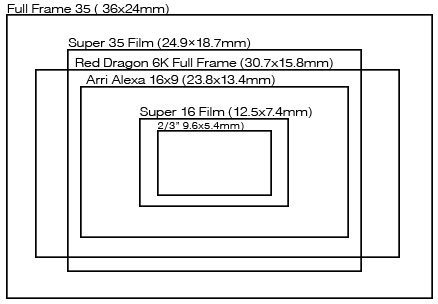
We say a lens ‘covers’ a sensor when its image circle produces an image over the full sensor size. So how do we determine if a lens image projection will ‘cover’ a specific sensor? Just overlay the two. Below you see the image circle of a Zeiss CP.2 prime lens, which produces an image circle of 43mm (diagonally), completely covering every sensor size from Full Frame 35 down to 1/3” sensors.
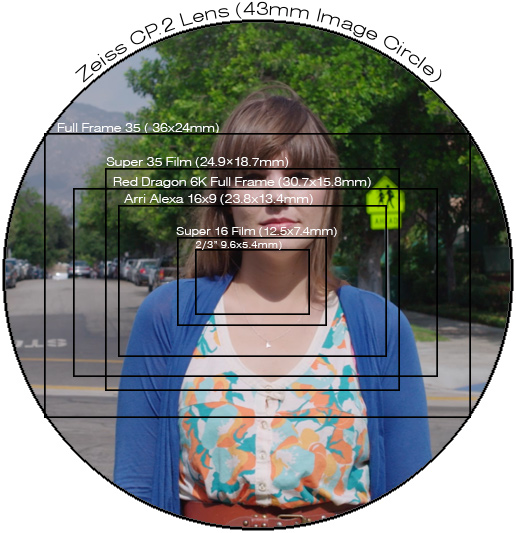
From the above diagram, you can see that a Zeiss CP.2 will work with a huge variety of sensors. But what about a Super 16mm lens with a 15mm image circle?
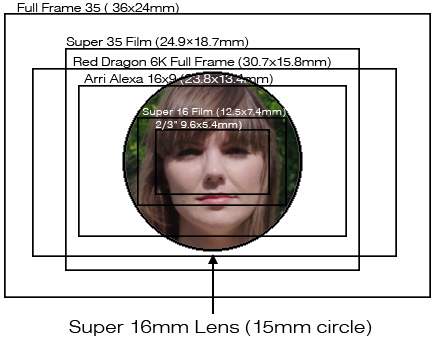
In the graphic above, the Super 16mm lens doesn’t cover anything larger than the ‘Super16’ sensor type. That makes sense of course, but notice what happens to all the larger sensors, they vignette. This is exactly what you would see if you put a Super 16mm lens on a camera like the Arri ALEXA or Sony F55, which both have sensors around the size of Super 35mm film.
Another Aspect
OK, so lens coverage isn’t all that complicated when you compare sensor sizes to a lens image circle. But many modern cameras offer a variety of aspect ratios and resolution modes, which allow the camera to record different areas of its sensor. Cameras that have this option are effectively altering their sensor size. The Red Dragon is a great example of a camera that has these modes.
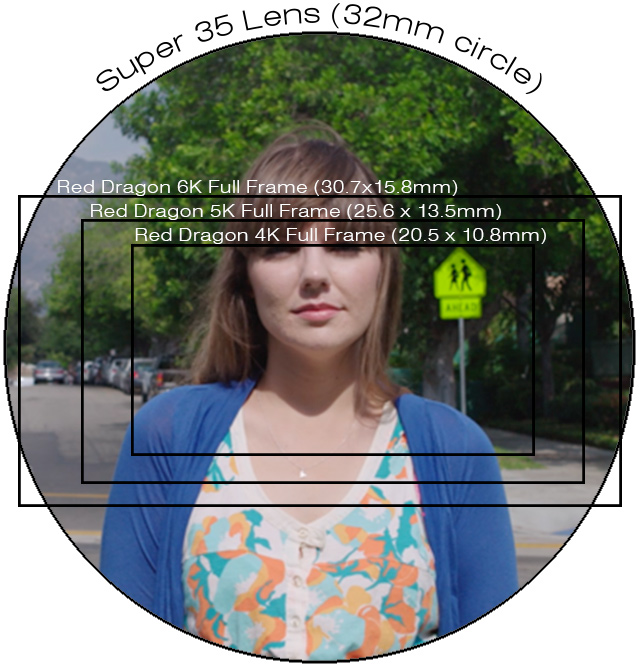
In the graphic above, I’ve overlaid a standard Super 35mm lens image circle over a Red Dragon sensor. The lines over the sensor indicate different recording areas and aspect ratios. As you can see, the area outside the 6K image isn’t covered by the lens, but the inside areas are all covered fine. So this lens doesn’t cover 6K resolution area on the Red Dragon.
This brings up another question, what does resolution have to do with lens coverage anyway? The answer is nothing. The 6K resolution area of the Red Dragon is physically 30.7x15.8mm (34.5 diagonal) in dimension. Meaning that the each photosite on the sensor is around 4.9um (0.0049 mm) in size. A different sensor type could have larger or smaller photosites in the same area, producing lower or higher resolutions.
In Conclusion
Let’s go back to our original questions: “Does my 16mm lens cover the Blackmagic Cinema camera sensor?” and “Does my lens cover 6K on the Red Dragon camera?” Super 16mm lenses do not cover the Blackmagic Cinema Camera sensor, as the image circle of Super16 glass is 15mm, and the BMCC sensor has a diagonal area of 18.4mm. As for the Red Dragon at 6K, the answer depends on the lens image circle. Having a 6K resolution has nothing to do with lens coverage, but it does describe a large area of the sensor. Lenses like the Zeiss CP.2 primes and CPZ.2 zooms are designed to cover the larger full frame sensor cameras, so we know they will work. Other Super 35mm lenses generally will not cover that image area, but the only way to know for sure is to test them.
A version of this article originally appeared in HDVideoPro.















